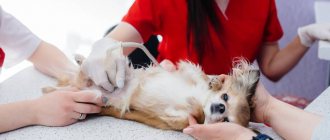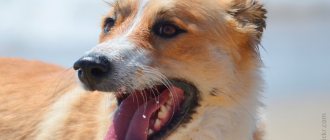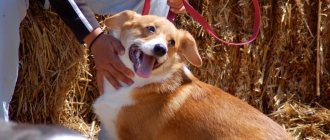Nausea and vomiting in pets is not uncommon. The reasons for the development of such a signal in the body can be various factors.
The appearance of vomiting in a puppy is not a reason to panic, since vomiting is a natural reflex, sometimes resulting from physiological reasons. It is important to monitor your pet's condition and pay attention to any changes in its condition.
A pet cannot indicate the reasons for poor health. In this regard, the owner must carefully monitor its condition. Before vomiting occurs, the dog suffers from nausea. You can understand that your pet is about to vomit by signs such as licking the muzzle, refusal to feed, increased salivation, reluctance to drink water, anxiety and chaotic movements. The puppy may have a strong stomach rumbling and belching. Depending on the factors that provoke vomiting in a dog, a bowel disorder may occur - constipation or diarrhea.
It is important to note that inexperienced dog owners confuse vomiting with physiological regurgitation. In case of eruption of gastric contents, food comes out in the form of digested particles, and when regurgitated, pieces of food come out unprocessed.
Main causes of food vomiting
When vomit is detected after eating food, the thought immediately appears that the animal has been poisoned. However, in most cases, this sign does not pose a threat to the pet's health.
If gastric emptying occurs for the first time and once, then there is nothing to worry about.
The main causes of vomiting with food:
- Food intolerance. The digestive tract is sometimes too sensitive to certain components of the feed. More often, vomiting occurs when consuming Economy class products or natural food from the list of prohibited foods. Characteristic symptoms: the appearance of rashes, redness on the skin, sneezing, tearing, and sometimes discharge from the nasal cavity.
- Poor quality food. Economy class products usually cause vomiting. Low quality can be easily identified by a strong, unpleasant odor. But sometimes the situation is the opposite - a complete lack of aroma is also a sign of poor quality dry granules.
- Pregnancy or breastfeeding. Toxicosis is an unpleasant problem not only for people. Dogs also suffer from nausea and vomiting during pregnancy due to hormonal fluctuations.
- Physical activity after eating food. If the dog is playful, then after the next meal it will begin to move a lot, jump, and run. This will cause the feed mass to shake in the stomach, which will slow down the digestion process.
- Motion sickness. Dogs, like people, can have trouble with travel. Vomiting is associated with destabilization of the vestibular apparatus, which begins to get confused in signals, causing disturbances in the functioning of the nervous system.
- Haste. It happens that the dog begins to swallow food quickly and in large pieces. The stomach does not have time to prepare to process food. It affects areas not covered by gastric juice, causing irritation of the mucous walls.
- Binge eating. When eating a large amount of food, a food lump rises to the throat, causing vomiting.
- Eating greens and grass in large quantities. Fiber from plants is poorly digested, but at the same time it releases substances that irritate the intestinal walls.
- Heatstroke, sunstroke. Overheating causes increased blood pressure and dilation of blood vessels, which reduces blood supply to organs. This slows down the digestion process.
The listed reasons are easy to identify and eliminate. It is enough to monitor the quality, freshness of food, portion sizes, and limit physical activity after meals. It is not a good idea to feed your pet before a trip or walk on a sunny day.
Interesting! Pet owners who keep male dogs often experience vomiting in their pets. Males lose their appetite when they see a female during mating season. Inexperienced owners try to trick the pet into giving it food, which leads to vomiting. The reason is that the body is configured to copulate with the female, and not to process food.
Treatment at a veterinary clinic
According to clinical data and symptoms, drug treatment is prescribed. The basis of therapy is:
- Reducing stomach cramps - antispasmodics are prescribed.
- Antiemetic drugs are used to relieve attacks of nausea and normalize contractions of the stomach walls.
- When vomiting with white foam, medications are recommended to reduce the acidity of gastric juice and relieve irritation.
- Prevention of dehydration of the body (dehydration) - infusion of glucose and Ringer-Locke solutions.
- Elimination of toxic substances from the body by prescribing enterosorbents that bind and remove toxic components.
The owner of the animal should always be on alert and note any changes in the condition of the pet. Timely assistance sometimes saves an animal's life.
Vomiting is a natural cleansing mechanism. But it may be associated with more serious diseases of the internal organs, indicating the presence of intoxication or infection.
The dog vomited after eating: the differences between vomiting and regurgitation
The dog vomited after eating: the difference between vomiting and regurgitation is an important question, since these phenomena are often confused. Before identifying differences, it is worth deciding on the meaning of the concepts.
Vomiting is a protective mechanism that is activated when foreign irritants are ingested. It could be a foreign body, a toxic substance, or a pathogenic bacterium. The mechanism manifests itself as a sharp spasm of the stomach muscles, which leads to its emptying.
Regurgitation is a reflex process when food masses are thrown from the stomach into the oral cavity.
Causes:
- swallowing food along with air;
- inhalation;
- inhibition of food down the throat or in the esophagus;
- overeating, which causes the formation of gases that leave the stomach through the oral cavity.
Regurgitation is a natural process that does not cause discomfort to the animal. Sometimes it occurs directly during a meal, which does not interfere with further eating.
Differences between vomiting and regurgitation:
- When regurgitating, there is no bile. Vomiting is accompanied by the release of mucus, bile, and saliva.
- Vomiting is accompanied by a powerful, abundant flow of feed mass. When regurgitating, food comes out formed, undigested, sometimes with saliva.
- Regurgitation is a natural phenomenon that does not cause discomfort. Vomiting is a sign of illness. It is accompanied by pain, weakness, and nausea.
- Vomiting occurs at any time. Regurgitation occurs after eating, sometimes together with belching.
Knowing how to distinguish vomiting from regurgitation will help determine the degree of danger of the phenomenon occurring to your pet. If a bad condition is detected, it is better to show the animal to a veterinarian.
Feed your puppy soft food
Your veterinarian may recommend a soft diet for a few days to help your puppy recover. The food can be obtained from your veterinarian, or you can prepare white rice and boiled skinless, boneless white meat chicken to give your puppy some nutrition while he recovers.
Also make sure your puppy continues to drink enough water. Call your veterinarian as soon as possible if your puppy vomits after eating a light meal or drinking water.
If your puppy has a more serious condition that is causing him to vomit, your veterinarian will treat him accordingly. In severe cases, hospitalization may be required.
What to do and how to help a dog if it is vomiting
The first question that worries owners who are faced with vomiting in their pet is what to do and how to help their dog if it is vomiting.
The correct decision would be to adhere to the following recommendations:
- Do not try to stop the emptying of the stomach. Vomiting is a defense mechanism as the body tries to get rid of foreign substances.
- Try to identify the cause of the pet’s poor condition. This will help the doctor when prescribing treatment.
- Determine the appearance, consistency and composition of vomit. Sometimes they may contain blood or fragments of parasites.
- Give your pet low-fat meat broth if the vomiting has stopped. In the future, a diet of boiled foods without salt is required.
- Keep your dog away from water for the first few hours. If the animal is thirsty, then it is allowed to give an ice cube for licking.
- Gently palpate the abdomen. Manipulation will help identify a foreign body if this is the cause of vomiting.
If the emptying of the stomach occurs once, then you will not need to see a doctor. However, you will have to change your diet. Acceptable foods: lean meat (chicken or turkey), oatmeal, brown rice, greens.
How to stop vomiting in puppies
Of course, the veterinarian will prescribe a comprehensive treatment, establishing the exact cause of the ailment. However, possible solutions include the following: correction of diet; antiemetics; antibiotics for the treatment of dysbiosis and bacterial ulcers; corticosteroids; surgical operations; course of chemotherapy.
Do not experiment with the course of treatment prescribed by your veterinarian. Do not self-medicate under any circumstances. Be sure to make another appointment to evaluate the effectiveness of the prescribed treatment.
Original publication:
Help! My Puppy Threw Up - Now What? Author: Byron de la Navarre
Vomiting caused by diseases
Vomiting caused by diseases is sometimes the only indicator of a deteriorating pet’s condition. Features: multiple gastric emptyings; the presence of blood, worms, and other inclusions in the vomit.
Diseases that lead to vomiting:
- Worm infestation. Typically, helminths adhere tightly to the walls of the digestive tract. However, sometimes they come out with vomit. There are 2 reasons for this phenomenon: a large number of parasites or severe intoxication of the body.
- Gastrointestinal diseases - gastritis, ulcers on the walls of the stomach or intestines, trauma to the mucous membrane (for example, when large bones hit). A common symptom is the presence of blood in the vomit.
- Food allergies. The reaction develops when low-quality ingredients or components to which the stomach walls are sensitive are ingested. Common irritants: ash (inorganic elements), flavor enhancers, preservatives, flavors, synthetic fillers.
- Poisoning. Causes: stale food, drug overdose, insect bites, chemicals, poisonous gases. In addition to vomiting, diarrhea, weakness, trembling, breathing problems, abdominal pain, and other symptoms are often observed.
If vomiting is a sign of illness, then only a veterinarian can help your pet.
The owner needs to remember the appearance of the vomit, the number of gastric emptyings, and their duration. This will help the veterinarian make a diagnosis and prescribe treatment.
What causes vomiting?
The list is quite long and includes: overeating; sudden changes in diet; very fast absorption of food; intolerance to certain foods; allergic reaction to a specific product; acute bacterial inflammation of the stomach; acute bacterial or viral infections of the gastrointestinal tract; parasites (giardia, roundworm, etc.); bloating or torsion of the stomach; tumors; metabolic disorders; heatstroke; adrenal gland disease or other metabolic diseases.
In order to determine the exact cause, it is necessary to collect and bring a sample of vomit to the veterinary clinic for analysis. Based on its nature (color, presence or absence of mucus, etc.), an experienced specialist will determine where possible problems are hidden.
When directly examining the animal, the veterinarian will try to determine whether a foreign object (bone) has gotten into your pet's mouth or is stuck. Temperature will be measured and stool samples will be taken. Perhaps through vomiting, your pet's body is cleansing itself of toxins.
How to choose the right food for your dog
Improper feeding is the main cause of nausea and vomiting. Therefore, close attention should be paid to your pet’s nutrition. Owners need to know how to choose the right food for their dog.
Recommendations:
- the higher the class, the better the quality of the feed. Super-premium products are suitable for dogs, especially purebred ones. It contains high quality ingredients and natural additives;
- Read the ingredients before purchasing. For example, the best source of protein is lean meat or fish, not organ meats. The composition should not contain preservatives, flavor enhancers, or other artificial additives;
- select food in accordance with the physiological needs or health status of the animal. Popular manufacturers produce lines for puppies, adults, elderly, and pregnant dogs. There are hypoallergenic products, medicinal and dietary foods.
Properly selected food will help avoid problems with allergies or intolerances. Providing balanced and nutritious feeding is one of the main tasks for the owner.
How to choose food and ready-made feeds so as not to encounter this problem?
To prevent your dog from developing such symptoms in the future, you need to follow the following rules when selecting food:
- Carefully study the composition of ready-made dry food for pets. Give preference to those products that do not contain synthetic additives, ash, or flavor enhancers. Currently, ready-made premium mixtures meet all the presented requirements. The dog breeder also needs to remember that he cannot give his pet exclusively dry food. They must be alternated with canned food.
- When feeding naturally, exclude fatty, fried, salty foods and smoked foods from the diet. It is not recommended to give your pet sweets or baked goods. The basis of the menu should be lean meats, offal, fish, vegetables, cereals (buckwheat, rice). If there are no contraindications, you can give him a small amount of milk, cottage cheese, sour cream.
- Completely remove long bones from the diet. Their fragments can injure the dog’s internal organs. They should be replaced with chicken necks, dried offal, and cartilage. They are safer and healthier for the animal.
- Monitor the quality of food offered to the animal. Make sure that he does not come across expired products. This rule applies not only to natural food, but also to dry food.
- Avoid foods that can trigger food allergies. This includes dry mixtures containing flavorings, some types of vegetables, and oatmeal. One of the dangerous products for adults is milk, which contains a large amount of lactose in its composition. Such foods should be introduced into the diet with extreme caution and, if possible, completely replaced with hypoallergenic analogues.
- Give your pet small portions of food. It is advisable to do this at the same time so that the dog does not suffer from extreme hunger or overeat. The treats themselves should be neither too hot nor too cold so that they do not irritate the stomach lining. Violating this rule can also provoke another attack of vomiting.
If you cannot choose high-quality food for your pet on your own, seek advice from a veterinarian. He will be able to create a suitable menu for the dog, taking into account its health status, general recommendations for feeding a particular breed, level of physical activity and other important factors. If you follow the recommendations of a specialist, you will not encounter a similar problem in the future.
Feed ingredients that cause nausea
- First of all, synthetic filler . Pay attention to the first element in the feed. According to standards, ingredients are arranged in descending order by weight. If soy comes first, this is the most abundant component in the feed. Good fillers are cereals, corn fiber, poultry bone meal. Cheap food uses “plant by-products” - this is a poor quality base that can cause nausea.
- Flavor enhancers. Sometimes they are added to feed and canned meat. A classic example is monosodium glutamate, which causes irritation of the gastric mucosa.
- Ash. These are all inorganic elements (mineralized structures and vitamins) with which the feed is enriched. If their proportion in the food is too large, the stomach will reject them, just like a coin or stone that a dog might accidentally swallow.
How to choose a quality one?
- Pay attention to the price category and class . So-called premium food is not a treat for every day, so the price is quite high.
- Manufacturer. Trust trusted companies, test new brands with caution.
- Study the composition based on the instructions above.
- If your pet is growing up, neutered, active, or aged, choose food with the appropriate name .
How can you tell if you are vomiting undigested food?
Symptoms that indicate that food is not digested :
- You can see the original products in the vomit.
- After vomiting, the dog may start eating it, or go to the bowl because it is still hungry.
- Breathing quickens, hypoxia occurs (lack of oxygen in tissues) , because all the blood rushes to the stomach to eliminate the problem.
- Decreased body temperature, cold sweat.
- The dog may begin to whine or whine.
- "Glass Eyes"
- Increased salivation.
What to do before the doctor arrives?
What to do if your dog has the urge to vomit ? The first thing you need to do before the veterinarian arrives is to assess the nature and frequency of vomiting, as well as the quality of the vomit. It is these indicators that will enable the doctor to assume that the dog has a particular disease and prescribe adequate treatment.
Assessing the nature of vomiting consists of several important points:
- determination of the frequency of vomiting and retching;
- examination of vomit, assessment of its consistency, appearance, color, as well as determination of the presence of impurities in it;
- recording the side symptoms that accompany vomiting: loss of appetite, fever, dizziness, lethargy, loss of interest in games, etc.;
- collecting an anamnesis of the disease (the nature of the dog’s feeding before vomiting, contact with other dogs, the possibility of the animal eating garbage while walking).
Regardless of the reasons for its development and the nature of the vomit, uncontrollable and prolonged vomiting can lead to rapid dehydration of the dog’s body and severe pathological conditions associated with it. Before the veterinarian arrives, it is necessary to provide the dog with plenty of fluids, and if the animal refuses water, pour liquid into the mouth through a syringe without a needle. Under no circumstances should you scold a dog for dirty furniture or carpets; you should treat it with understanding. Before examining the animal by a specialist, you should not feed it, since such actions can provoke an exacerbation of the pathological process.
Prevention
It is impossible to completely avoid the occurrence of nausea, but by following simple rules you can reduce the risk of its occurrence. First of all, you need to pay attention to feeding your pet. The puppy should be fed only high-quality and balanced food, avoid spicy, sweet and smoked foods. In addition, it is recommended to minimize the occurrence of stressful situations.
To prevent infection with infectious diseases and helminthic infestations, the animal must be regularly vaccinated and dewormed. To avoid poisoning by toxic substances, try to closely monitor your pet (do not allow him to pick up food on the street, hide medications and household chemicals).
Sudden onset of vomiting does not always indicate pathological processes in the pet’s body. But if the urge continues for a long time and is accompanied by additional symptoms, the animal in most cases requires the help of a veterinarian.
Symptoms of poisoning
Severe vomiting in a Spitz puppy is always observed when poisoned by any toxic substances or poor-quality food. In addition to gagging, the following signs indicate intoxication:
- lethargy and weakness of the animal;
- the puppy is vomiting and does not eat anything;
- increased body temperature;
- painful condition in the abdominal area;
- limb spasms;
- discharge of blood from the anus, eyes or nose;
- the dog is diarrhea.
Bloody diarrhea and vomiting observed in a puppy may be symptoms of acute intoxication. But some types of poisoning are difficult to distinguish from infectious processes, so veterinary diagnosis will be required to prescribe the correct treatment.











